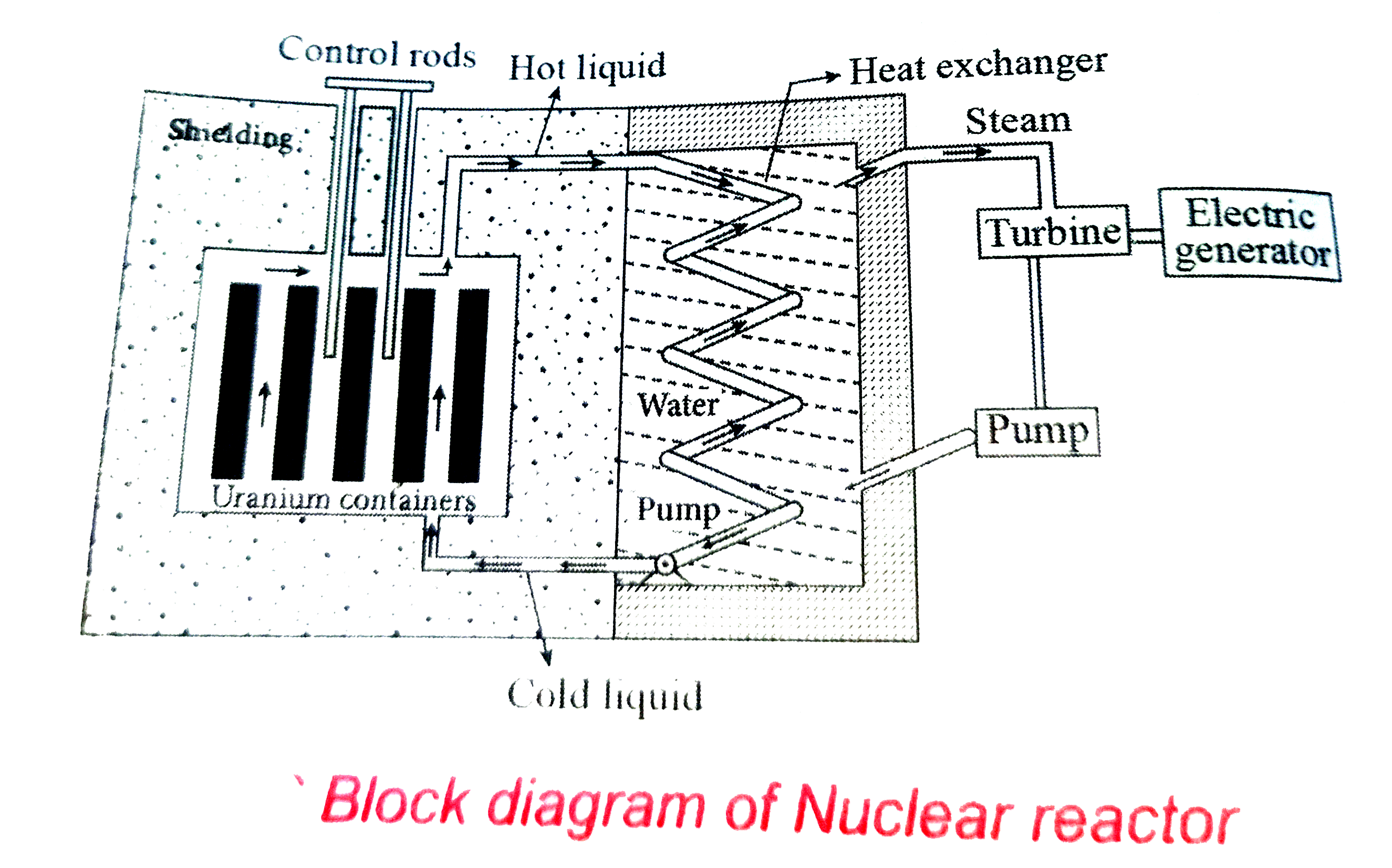Describe the working of nuclear reactor with a block diagram.Solution in Tamil
Nuclear reactor :
Nuclear reactor is a system in which the nuclear fission takes place in a self -sustained controlled manner and the energy produced is used either for research purpose or for power generation.
The main parts of a nuclear reactor are fuel, moderator and control rods. In addition to this, there is a cooling system which is connected with power generation set up.
Fuel :
The fuel is fissionable material usually uranium or plutonium. Naturally occuring uranium contains only 0.7% of 23592U and 99.3% are only 23592U. So the 23892U must be enriched such that it contains at least 2 to 4% of 23592U.
In addition to this, a neutron source is required to initiate the chain reaction for the first time. A mixture of beryllium with plutonium or polonium is used as the neutron source.During fission of 23592U, only fast neutrons are emitted but the probability of initiating fission by it in another nucleus is very low.Therefore , slow neutrons. Usually the moderators are chosen in such a way that it must be veruy lightnucleus having mass comparable to that of neutrons.Hene , these light nuclei undergo collision with fats neutrons and the speed of the neutron is reduced.
Most of the reactors use water , heavy water (D2O) and graphite as moderators. The blocks or uranium stacked together with blocks of graphite (the moderator) to form a large pile.

Control rods:
The control rods are used to adjust the reaction rate. During each fission, on an average 2.5 neutrons are emitted and in order to have the controlled chain reactions. Only one neutron is allowed to cause another fission and the remaining neutrons are absorbed by the control rods.
Usually cadmium or boron acts as control rod material and these rods are inserted into the uranium blocks. Depending on the insertion depth of control rod into the uranium, the average number of neutrons produced per fission is set to be equal to one or greater than one.
If the average number of neutrons produced per fission is equal to one, then reactor is said to be in critical state. In the fact, all the nuclear reactors are maintained in critical state by suitable adjustment of control rods. If it is greater than one , then reactor is said to be in super - critical and it may explode sooner or may cause massive destruction.
Shielding :
For a protection against harmful radiations, the nuclear reactor is surrounded by a concrete wall of thickness of about 2 to 2.5 m.
Cooling system :
The cooling system removes the heat generated in the reactor core. Ordinary water,heavy water and liquid sodium are used as coolant since they have very high specific heat capacity and have large boiling point under high pressure.
Thsi coolant passes through the fuel block and carries away the heat to the steam generator through heat exchanger. The steam runs the turbines which produces electricity in power reactors.
Topper's Solved these Questions
- ATOMIC AND NUCLEAR PHYSICSBOOK - FULL MARKSCHAPTER - ATOMIC AND NUCLEAR PHYSICSEXERCISE - Textual Evaluation Solved (Exercise)
11 Videos
- ATOMIC AND NUCLEAR PHYSICSBOOK - FULL MARKSCHAPTER - ATOMIC AND NUCLEAR PHYSICSEXERCISE - Additional question (Multiple Choice Question)
56 Videos
- ATOMIC AND NUCLEAR PHYSICSBOOK - FULL MARKSCHAPTER - ATOMIC AND NUCLEAR PHYSICSEXERCISE - Textual Evaluation Solved (Short Answer Questions)
27 Videos
- COMMUNICATION SYSTEMSBOOK - FULL MARKSCHAPTER - COMMUNICATION SYSTEMSEXERCISE - ADDITIONAL QUESTIONS (Additional problems)
3 Videos
Similar Questions
Consider two hydrogen atoms HAandHB in ground state. Assume that hydrogen atom HA is at rest and hydrogen atom HB is moving with a speed and make head-on collide on the stationary hydrogen atom HA. After the strike, both of them move together. What is minimum value of the kinetic energy of the moving hydrogen atom HB, such that any one of the hydrogen atoms reaches one of the excitation state.
View SolutionThe potential difference applied to an X-ray tube is 5kV and the current through it is 3.2 mA. Then the number of electrons striking the target per second is
View SolutionWhat are cathode rays?
View SolutionA radio can tune into any station in the 7.5 MHz to 12 MHz band. What is the corresponding wavelength band ?
View Solution(a) What is a nuclear reactor ? What is the fuel used in a nuclear reactor ? (b) With the help of a labelled diagram, describe the working of a nuclear power plant. (c ) How is the working nuclear reactor of a power plant shut down in an emergency ? (d) Name five places in India where nuclear power plants are located.
View SolutionExplain the principle and working of a nuclear reactor with the help of a labelled diagram.
View SolutionExplain the principle and working of a nuclear reactor with the help of a labelled diagram.
View SolutionDraw the block diagram of a nuclear reactor .
View SolutionWhat are the uses of nuclear reactor ?
View SolutionBriefly describe the working of a nuclear reactor
View SolutionDescribe the structure of nucleus with a suitable diagram.
View SolutionBriefly describe the working of a nuclear reactor.
View SolutionWhat is a nuclear reactor. Describe its working with a schematic diagram.
View SolutionWhat is a nuclear reactor? With the help of diagram explain its construction and working.
View SolutionDescribe the working of nuclear reactor with a block diagram .

View Solution
